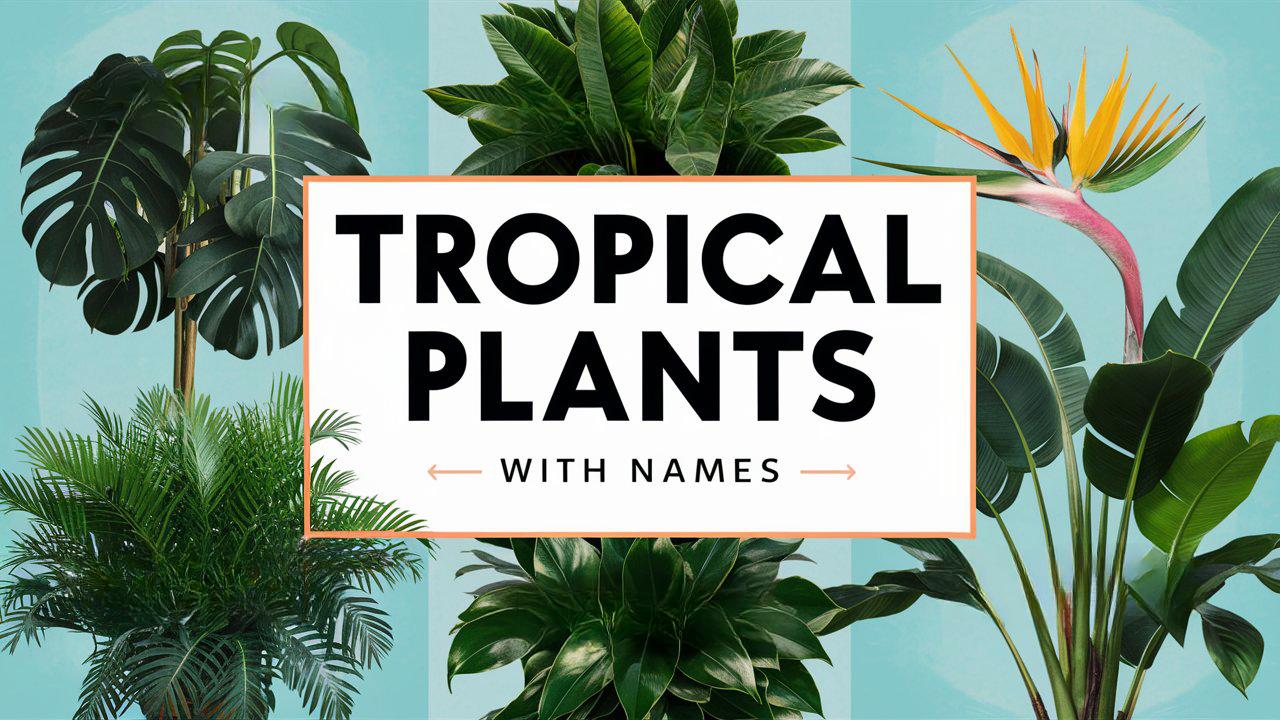In this post, we will explore various tropical plants, digging into their unique characteristics and names, providing insight into their origins, care requirements, and significance in landscaping and indoor decoration.
Asclepias Curassavica
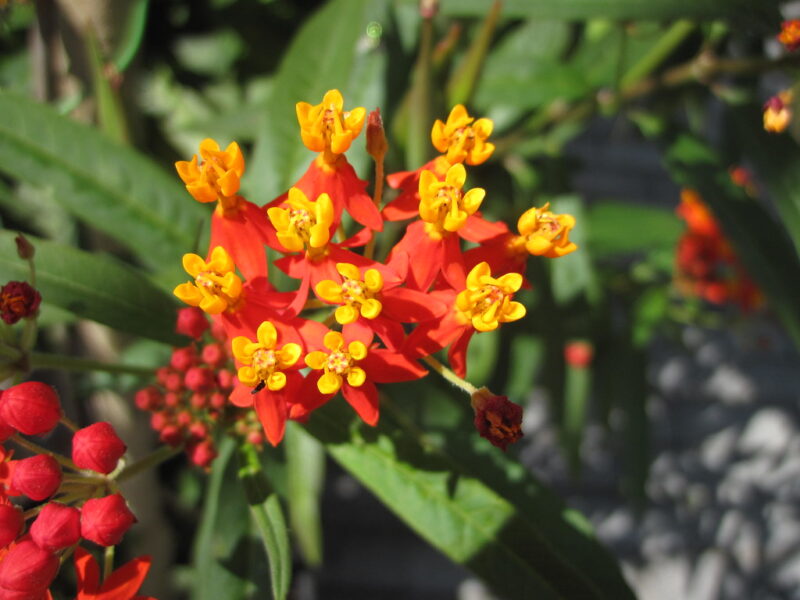
Asclepias curassavica, commonly known as tropical milkweed, is a perennial plant native to the warm regions of the Americas. Characterized by its vibrant orange and yellow flowers, this plant attracts butterflies, especially the monarch, for which it serves as a vital host. Beyond its ornamental value, Asclepias curassavica exhibits remarkable resilience in gardens, thriving in full sun and well-drained soil. Additionally, it plays a crucial role in local ecosystems by providing nectar and habitat for pollinators.
Brugmansia X Candida

Brugmansia x candida, often referred to as the angel’s trumpet, is revered for its stunning, trumpet-shaped blooms that hang elegantly from the branches. The flowers emit a sweet fragrance, particularly at night, attracting nocturnal pollinators. This plant prefers semi-tropical climates and requires abundant water and fertilizer to flourish. However, it should be noted that Brugmansia contains toxic compounds, making it essential to handle the plant with care, especially in households with pets and children.
Canna ‘Striata’
Canna ‘Striata’ is a striking cultivar known for its bold, variegated foliage and showy red-orange flowers. This tropical plant can grow up to 6 feet tall, making it a perfect choice for adding height and drama to garden borders or tropical-themed landscapes. Cannas thrive in sunny locations with rich, moist soil, and they are relatively easy to care for. The rhizomes can be dug up and divided in the fall, allowing gardeners to expand their collection with ease.
Colocasia Esculenta

Colocasia esculenta, commonly known as taro, features large, heart-shaped leaves that can grow up to three feet long. This plant is not only striking in appearance but also valuable as a staple food crop in many tropical regions, where the corms are rich in carbohydrates. Colocasia thrives in wet, humid environments and is often grown in ponds or bog gardens to mimic its native habitat. Its lush foliage adds an exotic flair to any landscape.
Cuphea ‘David Verity’

Cuphea ‘David Verity’ is a hybrid plant that captivates with its unique tubular flowers resembling those of a trumpet. The striking red and purple colors attract hummingbirds and butterflies, making it a popular choice for wildlife gardens. This hardy perennial flourishes in well-drained soil and thrives in full sun, creating a colorful and lively addition to garden beds. Cuphea ‘David Verity’ demonstrates excellent drought tolerance once established, making it a low-maintenance option for gardeners.
Euphorbia Cotinifolia

Euphorbia cotinifolia, known as the Caribbean copper plant, is distinguished by its eye-catching, reddish-bronze foliage that exudes a tropical feel. This shrub can grow up to 10 feet tall and is known for its resilience in hot, sunny environments. It is often used in landscape designs for its visual impact and ability to thrive in poor soils. The sap of Euphorbia plants can be irritating, so caution is advised when handling. Nonetheless, its unique coloration makes it a favored choice among landscape architects.
Ipomoea Batatas

Ipomoea batatas, commonly referred to as sweet potato vine, is not only admired for its lush, ornamental foliage, but it is also valued as a food source. The plant produces edible tubers that are rich in nutrients and beloved in diverse culinary traditions. Varieties can range in leaf shape and color, from deep green to purple or even variegated forms. Sweet potato vines are versatile and can be grown in containers or as ground cover, thriving in sunny locations where they can spread happily.
Manihot Esculenta ‘Variegata’
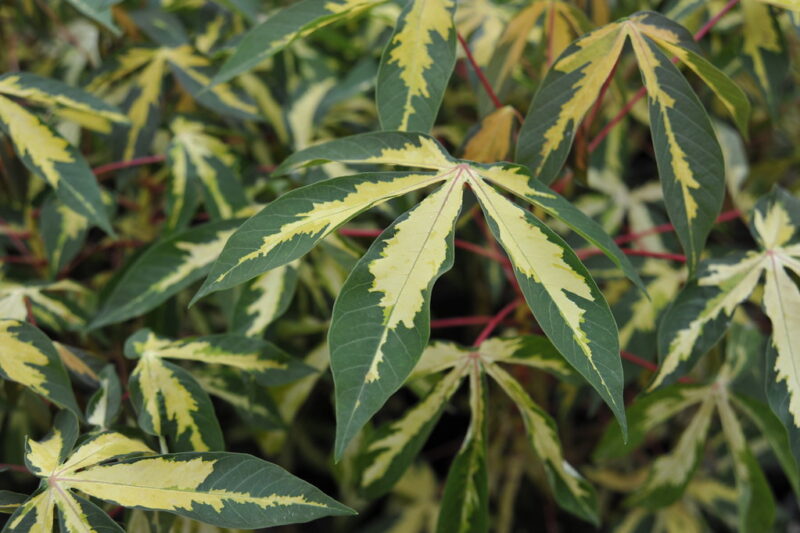
Manihot esculenta ‘Variegata’, often known as variegated cassava, is a delightful tropical shrub characterized by its unique cream-and-green marbled leaves. While cassava is primarily grown for its starchy roots, this variegated variety is favored for its striking appearance in ornamental gardens. It requires plenty of sunlight and well-drained soil to thrive, making it a perfect candidate for tropical-themed gardens or landscapes.
Musa Basjoo

Musa basjoo, commonly known as Japanese banana, is a hardy banana plant that can withstand colder temperatures compared to its tropical counterparts. This stunning plant features large, paddle-shaped leaves and can grow up to 15 feet tall, enhancing the exotic look of any garden. While it does not produce edible fruit in colder climates, it remains a popular ornamental choice for its dramatic foliage. Musa basjoo thrives in full sun and requires regular watering to maintain its lush appearance, making it essential for gardeners looking to create a tropical atmosphere without extreme maintenance.
Salvia Splendens

Salvia splendens, commonly known as scarlet sage, is a favorite among tropical garden enthusiasts for its vivid red flowers that bloom profusely throughout the warm months. This perennial thrives in well-drained soil and full sun, making it easy to incorporate into various landscape designs. Hummingbirds and butterflies are particularly attracted to its bright blooms, enhancing local biodiversity. Salvia splendens is often used in mass plantings or as a border plant, thanks to its compact growth habit and vibrant color.
Anthurium

Anthurium, often recognized by its heart-shaped flowers and glossy, dark green leaves, is a popular choice for both indoor and outdoor planting. The flowers, which can be red, pink, or white, are sometimes mistaken for plastic due to their shiny appearance. This tropical plant thrives in humidity and indirect sunlight, making it an excellent candidate for tropical-themed homes and greenhouses. Anthuriums are also known for their longevity as cut flowers, providing an exotic touch to floral arrangements.
Bird of Paradise

The Bird of Paradise (Strelitzia reginae) captures attention with its iconic, colorful flowers that resemble the plumage of exotic birds, hence its name. Native to South Africa, this tropical plant can grow quite large, reaching heights of up to 5 feet. It requires well-drained soil, full sun, and regular watering to flourish. The Bird of Paradise is a striking choice in landscaping or as a centerpiece in indoor settings, known for adding an immediate tropical flair and attracting pollinators.
Cordyline Fruticosa

Cordyline fruticosa, or ti plant, is cherished for its vibrant foliage that ranges in color from deep green to striking purple and pink hues. This versatile tropical plant can grow anywhere from 3 to 10 feet tall, making it suitable for both container gardening and landscaping. It thrives in warm, humid environments and partial shade, providing stunning color contrast in shady corners of the garden. Additionally, Cordyline fruticosa is often used in Hawaiian culture for its traditional significance and medicinal properties.
Ficus

The Ficus genus encompasses a wide variety of species, with Ficus elastica (rubber tree) and Ficus lyrata (fiddle-leaf fig) being among the most popular tropical plants. Ficus elastica features shiny, dark leaves and is known for its air-purifying qualities, making it a favored houseplant. Ficus lyrata, known for its dramatic, violin-shaped leaves, has recently gained popularity as a statement plant in modern interiors. Both thrive in bright, indirect light and prefer to dry out slightly between waterings, embodying the classic traits of tropical greenery.
Palm Trees

Palms are synonymous with tropical environments, making them a staple in many exotic landscapes. From the towering royal palm (Roystonea regia) to the dwarf palmetto (Sabal minor), these majestic plants impress with their unique trunk formations and beautiful fronds. Palms require full sun and well-drained soil, flourishing in warm climates. Beyond their aesthetic appeal, many palm species produce edible fruits, oils, and fibers, demonstrating their ecological and cultural significance worldwide.
Dieffenbachia Seguine
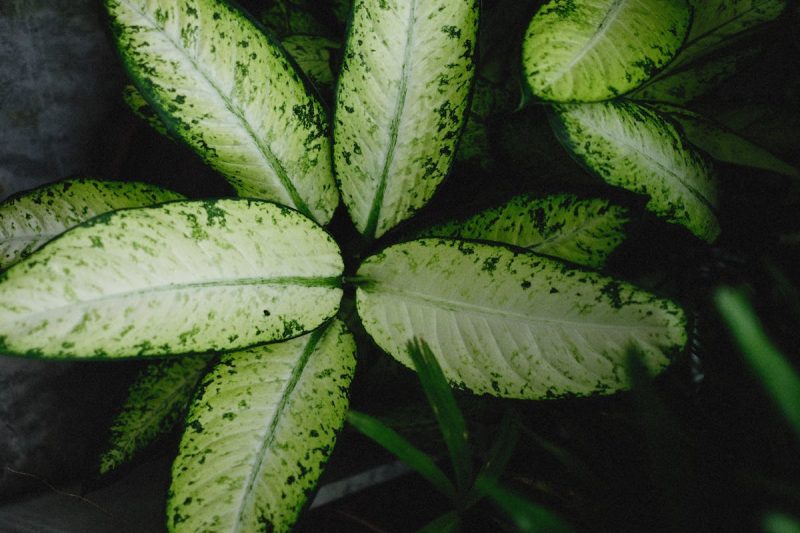
Dieffenbachia seguine, commonly known as dumb cane, is noted for its lush, variegated foliage that can enhance any indoor or outdoor space. This plant can reach heights of up to 6 feet and prefers indirect light and moderately moist soil. While Dieffenbachia is popular for its attractive leaves, it is important to handle this plant with care, as its sap can cause temporary speech impairment if ingested, hence the name “dumb cane.” Its striking appearance makes it a common choice in offices and homes.
Spathiphyllum

Spathiphyllum, or peace lily, is renowned for its elegant white flowers and glossy green leaves. This plant is particularly popular for indoor gardening due to its air-purifying qualities and low light tolerance. Peace lilies thrive in consistently moist soil but can tolerate dry conditions, making them forgiving houseplants. Their ability to bloom even in low light adds to their appeal, providing lasting beauty and an air of tranquility to any space.
Croton

Croton (Codiaeum variegatum) is celebrated for its vibrant and colorful foliage, showcasing a mix of yellow, red, and green leaves that can brighten any garden or interior space. This tropical shrub is commonly grown outdoors in warmer climates but can also thrive indoors with the right care. Crotons prefer bright light and require regular watering to maintain their striking appearance. Their bold colors and patterns make them popular as ornamental plants and statement pieces in landscape design.
Aloe Vera

Aloe vera is a well-loved succulent known for its distinctive, fleshy leaves and healing properties. Commonly used in topical applications and wellness products, this tropical plant is also valued for its ability to thrive in low-water conditions, making it an excellent choice for both indoor gardening and landscapes in drier climates. Aloe vera prefers bright, indirect sunlight and well-drained soil, allowing the leaves to flourish while preventing root rot. Beyond its health benefits, including soothing burns and promoting skin hydration, Aloe vera adds a touch of tranquility and resilience to any plant collection.
Ficus Elastica
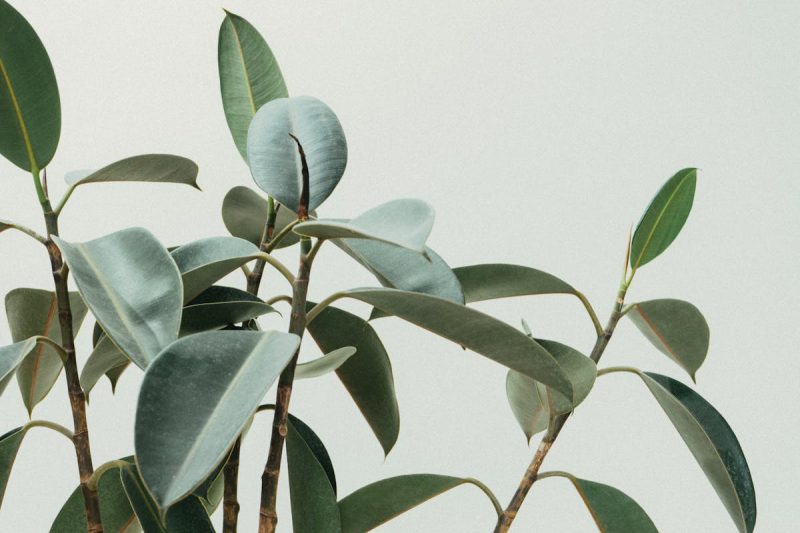
Ficus elastica, commonly known as the rubber plant, is distinguished by its large, glossy leaves that can grow up to 12 inches long. Originating from Southeast Asia, this tropical evergreen tree can reach impressive heights when planted in favorable outdoor conditions, making it a striking landscape feature. As a houseplant, Ficus elastica is celebrated for its air-purifying abilities and ease of care. It thrives in bright, indirect light and only requires watering when the topsoil is dry, making it perfect for both novice and experienced plant enthusiasts alike. Its dramatic foliage brings a touch of elegance to interiors, fitted into both modern and classic design schemes.
Sansevieria Trifasciata
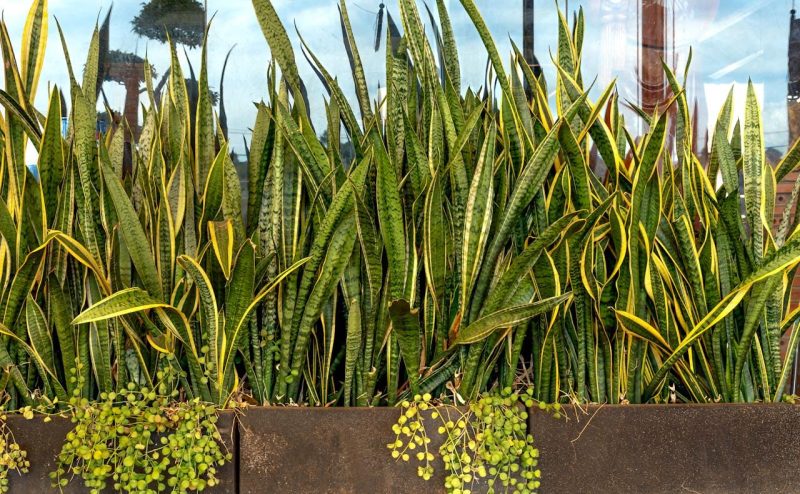
Sansevieria trifasciata, commonly known as snake plant or mother-in-law’s tongue, is celebrated for its striking upright leaves that resemble swords. Typically featuring a beautiful green coloration with gray banding, this plant is incredibly resilient, thriving in low light conditions and requiring minimal water. Its air-purifying capabilities make it a favorite for interiors, and its tolerance for neglect makes it an ideal choice for busy individuals. Like many tropical plants, it can also contribute to a humid environment, making it a popular choice in homes.
Philodendron Hederaceum

Philodendron hederaceum, also known as the heartleaf philodendron, is a popular trailing plant revered for its charming heart-shaped leaves. Often used as a houseplant, this species is adaptable, thriving in a variety of lighting conditions from low to bright indirect light. The climbing or trailing nature of Philodendron hederaceum makes it perfect for hanging baskets or shelves, where its lush vines can spill over beautifully. With regular watering and occasional pruning, this plant will create a lively and inviting atmosphere.
Schefflera Arboricola
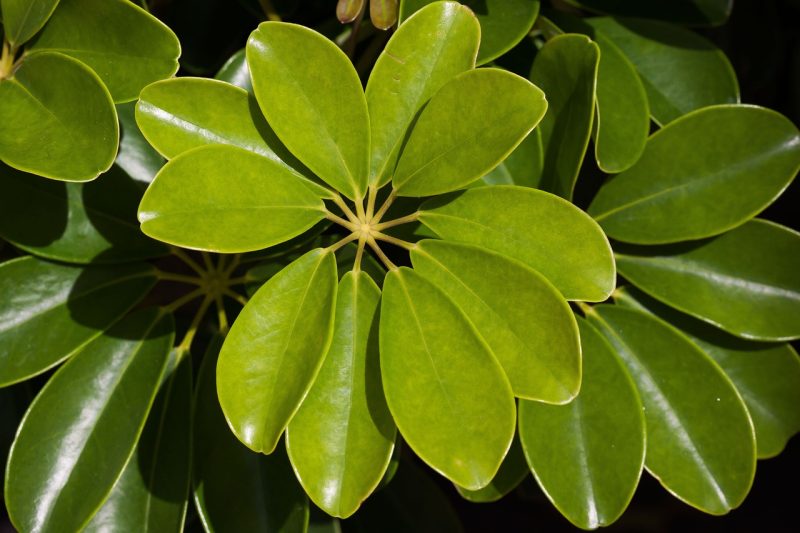
Schefflera arboricola, commonly called the dwarf umbrella tree, is a robust woody shrub prized for its glossy, palmate leaves that resemble tiny umbrellas. This plant can reach heights of up to 4 feet indoors and much taller when grown outdoors in tropical or subtropical climates. While Schefflera is adaptable to different light conditions, it thrives in bright, indirect sunlight. It requires moderate watering to prevent wilting, making it a favorable option for both homes and office environments due to its air-purifying properties.
Aglaonema Commutatum

Aglaonema commutatum, often called Chinese evergreen, is a popular choice among indoor plant enthusiasts for its striking foliage and ability to tolerate low-light conditions. With leaves that display a stunning range of colors from deep green to silvery variegations, this plant adds an ornamental touch to any collection. Aglaonema prefers humid environments, making it suitable for bathrooms or kitchens. Regular watering and occasional fertilization during the growing season will keep this lush tropical plant vibrant and healthy.
Monstera Deliciosa

Monstera deliciosa, famously known as the Swiss cheese plant, is recognized for its large, fenestrated leaves that create a dramatic focal point indoors or outdoors. This climbing plant can be trained to grow on a trellis or support, making it an eye-catching addition to any space. Monstera thrives in bright, indirect light and appreciates regular watering, allowing the top soil to dry slightly in between. In addition to its aesthetic appeal, Monstera deliciosa is also known for producing edible fruit under the right conditions, adding to its allure.
Tacca Integrifolia

Tacca integrifolia, commonly referred to as the white bat flower, is an extraordinary tropical plant that captivates onlookers with its unique bat-like blossoms. The large, white flowers are adorned with long, whisker-like tendrils, creating a dramatic display. Originating from the tropical regions of Southeast Asia, Tacca prefers warm, humid conditions and thrives in rich, well-draining soil. While it may be less common in cultivation, it is a true standout for botanical enthusiasts looking to add an unusual specimen to their collection.
Psychopsis Papilio

Psychopsis papilio, known as the butterfly orchid, presents a mesmerizing floral display reminiscent of delicate butterflies in flight. This epiphytic orchid is characterized by its long, arching stems and unique, intricate flowers featuring a combination of yellow and brown hues. Preferring bright, indirect light and high humidity, this orchid requires careful attention to watering, as overly saturated roots can lead to rot. Psychopsis papilio thrives in settings where it can be admired, from well-lit windows to garden conservatories.
Saintpaulia Ionantha

Saintpaulia ionantha, widely known as African violet, is a charming flowering plant cherished for its beautiful, fuzzy leaves and vibrant purple blooms. This compact plant thrives indoors, favoring bright but indirect sunlight. Regular watering, with a focus on preventing water from sitting on leaves, is crucial to its success. African violets come in a rich array of colors and are often used to add cheerful bursts to windowsills and decorative displays.
Gaillardia

Gaillardia, also known as blanket flower, is a hardy perennial that brings intense color to tropical gardens with its vibrant red, yellow, and orange blooms. The blanket flower is drought-tolerant and thrives in well-drained soil, making it a popular choice for gardeners in warm climates. It loves full sun, producing a continuous display of flowers from summer to fall, attracting butterflies and pollinators to your garden. Gaillardia’s cheerful appearance contributes to colorful borders or flower beds, and it can also be used as a cut flower for fresh arrangements.
Amaryllis

Amaryllis is renowned for its striking trumpet-shaped flowers that bloom in spectacular bursts of color, including red, pink, white, and speckled varieties. This tropical bulb is typically grown indoors and is especially popular during the holiday season. Amaryllis prefers bright, indirect light and moderate watering, allowing the topsoil to dry out between waterings. With proper care, an amaryllis bulb can produce multiple blooms, making it a beautiful addition to any seasonal décor.
Caladium Bicolor

Caladium bicolor is admired for its wildly variegated leaves that come in a range of colors, including pink, red, white, and green. Often referred to as angel wings or elephant ears, these tropical plants thrive in humid environments and partial shade, making them a perfect choice for adding a pop of color to shadier spots in gardens. Caladiums require consistent moisture but should not be waterlogged. Their stunning foliage is particularly effective as a focal point in flower beds or containers.
Chlorophytum Comosum

Chlorophytum comosum, popularly known as spider plant, is a resilient houseplant known for its arching green leaves and offshoots that resemble spiders hanging down. Spider plants prefer indirect sunlight and can tolerate neglect, making them ideal for beginners. They are also known for their air-purifying qualities, helping to remove toxins from the air. Spider plants can be propagated easily by planting the spiderettes, allowing you to share this delightful plant with friends and family.
Yucca Elephantipes

Yucca elephantipes, commonly referred to as the giant yucca or spineless yucca, is characterized by its tall trunk and rosette of sharp, arching leaves. This striking specimen can grow indoors to several feet tall, giving a dramatic, architectural aspect to interiors. Yucca elephantipes prefers bright, indirect sunlight and should be watered thoroughly, allowing the soil to dry out completely between waterings. With its rugged appearance and ease of care, this plant can serve as a stylish statement piece in a living space or office.
Araucaria Heterophylla

Araucaria heterophylla, also known as the Norfolk Island pine, is a unique coniferous plant that can grow tall and straight, resembling a traditional Christmas tree. This tropical tree does well in bright light and will thrive with regular watering, maintaining moist but well-drained conditions. While it is sensitive to cold temperatures, when grown indoors, it can make a stunning living decoration. Araucaria heterophylla adds elegance and a touch of nostalgia to homes and gardens with its festive allure.
Begonia

The Begonia genus encompasses a wide variety of species, many of which are beloved for their attractive foliage and vibrant blooms. Begonias thrive in bright, indirect light and prefer consistently moist soil that is well-draining. Depending on the variety, begonias can be used as houseplants, bedding plants, or container displays, adding color and texture to gardens and indoor spaces. Their unique leaf shapes and beautiful flower clusters make them versatile favorites for any gardener.
Medinilla Magnifica

Medinilla magnifica, often known as the chandelier plant, is celebrated for its stunning clusters of pink flowers that dangle elegantly, resembling chandeliers. This tropical species requires bright, indirect sunlight and high humidity to flourish, making it suitable for greenhouses and well-lit humid areas within homes. Regular watering is necessary to maintain soil moisture, but care should be taken not to let it become waterlogged. Medinilla magnifica adds a dramatic touch to any plant collection and is a unique conversation piece.
Calliandra Haematocephala

Calliandra haematocephala, commonly known as the red powder puff tree, is distinguished by its vibrant red, fluffy flower clusters that resemble puffs of powder. This tropical shrub can reach heights of up to 10 feet and is often grown as a flowering hedge or specimen plant in warm climates. It thrives in full sun and requires moderate watering, producing stunning blooms that attract pollinators like butterflies and hummingbirds. The unique flowers and lush foliage make it a popular choice for tropical landscapes.
Zamioculcas Zamiifolia
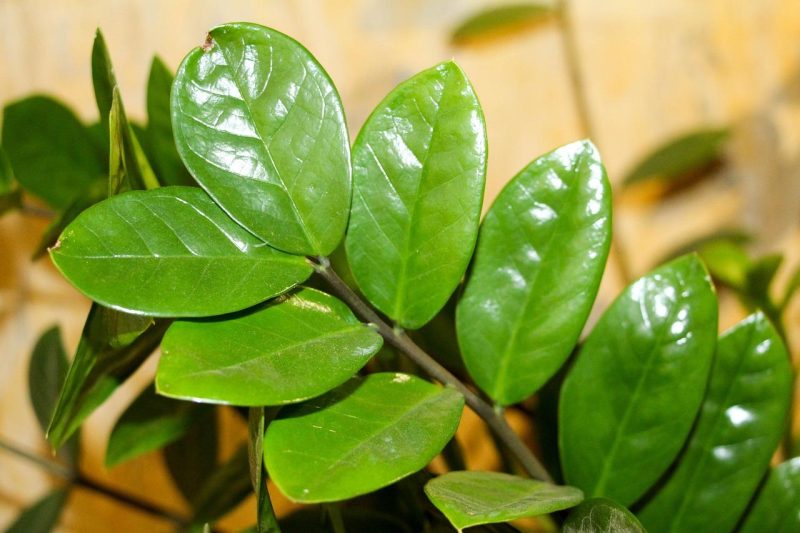
Zamioculcas zamiifolia, known commonly as ZZ plant, is an extraordinarily resilient houseplant cherished for its glossy, dark green leaves and ability to thrive in low-light conditions. ZZ plants require infrequent watering, making them a favorite among busy plant owners or those new to gardening. This attractive plant adapts well to varying indoor environments and is also praised for its air-purifying properties, adding greenery without demanding much attention. Its upright growth habit and smooth foliage make it a sophisticated addition to any room, whether in a home or an office setting.
Crassula Ovata

Crassula ovata, better known as the jade plant, is a popular succulent that symbolizes good luck and prosperity. Its thick, oval-shaped leaves grow in beautiful clusters, often taking on a lush green hue with a hint of red along the edges when exposed to bright light. Jade plants prefer bright, indirect sunlight and need minimal watering, making them an excellent choice for beginners and those looking for low-maintenance houseplants. With maturity, jade plants can be shaped into small trees, adding character and charm to indoor spaces or gardens.
Epipremnum Aureum

Epipremnum aureum, commonly referred to as pothos or golden pothos, is a highly adaptable and hardy houseplant known for its trailing vines and heart-shaped leaves. This tropical vine is favored for its vibrant green foliage, which often features golden or white variegation. Pothos can thrive in a range of lighting conditions—from low light to bright, indirect light—and only needs watering when the soil has dried out. Its ability to purify the air and grow in various environments makes it a favorite among plant enthusiasts. Whether draping over a shelf, cascading from a hanging basket, or climbing a trellis, Epipremnum aureum adds a lush, verdant touch to any space.


